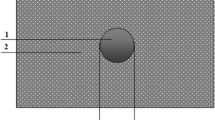Abstract
The development and relaxation of stresses in epoxy matrix-filler systems were studied experimentally under isotropic thermal and baric effects. Data on the nuclear quadrupole resonance of the filler crystals were analyzed using an empirical model for the relaxation processes in the matrix of the composite material. The effective stress-relaxation time was found to depend on the temperature, external pressure, and the magnitude and type of deformations of the polymer matrix.
Similar content being viewed by others
References
K. V. Ermolaev, V. P. Tarasov, L. N. Erofeev, et al., “Pulse NQR method for measuring internal stresses in cured epoxy,” Vysokomol. Soed., Ser. B., 40, 10, 1715–1719 (1998).
N. E. Ainbinder, A. S. Azheganov, A. V. Danilov, and N. K. Shestakova, “Application of the NQR method for studying polymer materials,” J. Mol. Struct., 345, 105–112 (1995).
R. R. Hewitt and B. Mazelsky, “Nuclear quadrupole resonance as a nondestructive probe in polymers,” J. Appl. Phys., 43, No. 8, 3386–3392 (1972).
N. E. Ainbinder, A. S. Azheganov, V. P. Begishev, and N. K. Shestakova, “Using the NQR method to measure stresses in the matrix-filler system in composite materials,” Pis’ma Zh. Tekh. Fiz., 23, No. 9. 14–18 (1997).
A. S. Azheganov, V. P. Begishev, D. A. Gorinov, et al., “A nuclear quadrupole resonance study of the elastic and thermal properties of solid composite materials,” Polym. Sci., Ser. B, 46, Nos. 9–10, 288–296 (2004).
H.-K. Roth, F. Keller, and H. Schneider, Hochfrequenzspektroskoie in der Polymerforshung, Akademie-Verlag, Berlin (1984).
G. M. Bartenev and Yu. V. Zelenev (eds.), Relaxation Phenomena in Polymers [in Russian], Khimiya, Leningrad (1972).
D. S. Sanditov and G. M. Bartenev, Physical Properties of Disordered Structures [in Russian], Nauka, Novosibirsk (1982).
I. N. Shardakov, N. A. Trufanov, V. P. Begishev, et al., “Determining relations of the thermomechanical behavior of amorphous polymers in the highly elastic and glassy states,” Preprint, Institute of Mechanics of Continuous Media, Ural Division, USSR Academy of Sciences, Sverdlovsk (1990).
T. F. Irzhak, S. E. Varyukhin, and Yu. A. Ol’khov, “Physical network model: Relaxation properties of polymers in the highly elastic state,” Vysokomol. Soed., Ser. A., 39, No. 4, 671–676 (1997).
G. Lubin (ed.), Handbook of Composites, Van Nostrand Reinhold Company, New York (1982).
Yu. S. Lipatov, Interfacial Phenomena in Polymers, Naukova Dumka, Kiev (1980).
Author information
Authors and Affiliations
Additional information
__________
Translated from Prikladnaya Mekhanika i Tekhnicheskaya Fizika, Vol. 47, No. 4, pp. 104–114, July–August, 2006.
Rights and permissions
About this article
Cite this article
Azheganov, A.S., Begishev, V.P., Gorinov, D.A. et al. Development and relaxation of internal stresses in granular composites with an epoxy matrix. J Appl Mech Tech Phys 47, 547–555 (2006). https://doi.org/10.1007/s10808-006-0088-y
Received:
Issue Date:
DOI: https://doi.org/10.1007/s10808-006-0088-y



